
Independent alternation of generations is present in
a. Angiosperms
b. Gymnosperms
c. Pteridophytes
d. Bryophytes
Answer
506.7k+ views
Hint: Independent alteration of geneations is a natural phenomena under which an organism keeps fluctuating between modes of reproduction (that is, sexual and asexual) over the generations.
Complete Answer
It is a high standard approach used by lower levels of plants for maintaining their species' population percentage. We can easily understand this phenomenon with the help of the following example.
Liverworts are low level plants. Conventionally they reproduce asexually, that is, single parent organisms give rise to daughter organisms which are capable enough of leading an individual life. Such a reproduction is achieved by fragmentation in which the parent organism breaks into two or more daughter organisms. However, over a few generations, suddenly the organism adopts a sexual mode of reproduction in which two parent organisms are involved in formation of the daughter organisms. Such a process is complete through gamete formation in parents leading to their fusion and formation of diploid zygote.
It is worthy to note that asexual reproduction is slow and steady process and does not produce variety. This increases chances of extinction of species. However, the sexual mode of reproduction brings varieties which improve species health. This might be the possible reason organisms like liverworts switch to sexual mode of reproduction.
Thus, we can say that option C) Pteridophytes is the correct answer.

Note:
In the options mentioned above, only pteridophytes are capable of exhibiting independent alternation of generations. They have an authentic vascular body that allows fluctuation of reproductive mode over generations. Whereas, except bryophytes (which reproduces asexually) gymnosperms and angiosperms are high level plants that reproduce sexually, therefore does not require fluctuation.
Complete Answer
It is a high standard approach used by lower levels of plants for maintaining their species' population percentage. We can easily understand this phenomenon with the help of the following example.
Liverworts are low level plants. Conventionally they reproduce asexually, that is, single parent organisms give rise to daughter organisms which are capable enough of leading an individual life. Such a reproduction is achieved by fragmentation in which the parent organism breaks into two or more daughter organisms. However, over a few generations, suddenly the organism adopts a sexual mode of reproduction in which two parent organisms are involved in formation of the daughter organisms. Such a process is complete through gamete formation in parents leading to their fusion and formation of diploid zygote.
It is worthy to note that asexual reproduction is slow and steady process and does not produce variety. This increases chances of extinction of species. However, the sexual mode of reproduction brings varieties which improve species health. This might be the possible reason organisms like liverworts switch to sexual mode of reproduction.
Thus, we can say that option C) Pteridophytes is the correct answer.

Note:
In the options mentioned above, only pteridophytes are capable of exhibiting independent alternation of generations. They have an authentic vascular body that allows fluctuation of reproductive mode over generations. Whereas, except bryophytes (which reproduces asexually) gymnosperms and angiosperms are high level plants that reproduce sexually, therefore does not require fluctuation.
Recently Updated Pages
Why are manures considered better than fertilizers class 11 biology CBSE

Find the coordinates of the midpoint of the line segment class 11 maths CBSE

Distinguish between static friction limiting friction class 11 physics CBSE

The Chairman of the constituent Assembly was A Jawaharlal class 11 social science CBSE

The first National Commission on Labour NCL submitted class 11 social science CBSE

Number of all subshell of n + l 7 is A 4 B 5 C 6 D class 11 chemistry CBSE

Trending doubts
1 Quintal is equal to a 110 kg b 10 kg c 100kg d 1000 class 11 physics CBSE

Why is steel more elastic than rubber class 11 physics CBSE

What is boron A Nonmetal B Metal C Metalloid D All class 11 chemistry CBSE

What is Environment class 11 chemistry CBSE

Bond order ofO2 O2+ O2 and O22 is in order A O2 langle class 11 chemistry CBSE

How many squares are there in a chess board A 1296 class 11 maths CBSE




